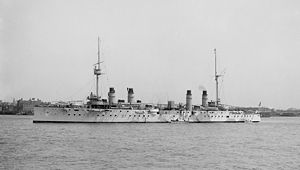French cruiser Dupleix (1900)

| |
| History | |
|---|---|
| Name | Dupleix |
| Namesake | Joseph François Dupleix |
| Ordered | 18 December 1897 |
| Builder | Arsenal de Rochefort |
| Cost | FF16,308,850 |
| Laid down | 18 January 1899 |
| Launched | 28 April 1900 |
| Commissioned | 15 September 1903 |
| Decommissioned | 1 May 1919 |
| Stricken | 27 September 1919 |
| Fate | Sold for scrap, 1922 |
| General characteristics | |
| Class and type | Dupleix-class armored cruiser |
| Displacement | 7,700 t (7,578 long tons) |
| Length | 132.1 m (433 ft 5 in) ( o/a ) |
| Beam | 17.8 m (58 ft 5 in) |
| Draft | 7.46 m (24 ft 6 in) |
| Installed power |
|
| Propulsion | 3 shafts; 3 triple-expansion steam engines |
| Speed | 20.9 knots (38.7 km/h; 24.1 mph) |
| Range | 6,450 nmi (11,950 km; 7,420 mi) at 10 knots (19 km/h; 12 mph) |
| Complement |
|
| Armament |
|
| Armor |
|
The French cruiser Dupleix was the lead ship of her class of three armored cruisers built for the French Navy in the first decade of the 20th century. Designed for overseas service and armed with eight 164.7-millimeter (6.5 in) guns, the ships were smaller and less powerfully armed than their predecessors. Completed in 1903, Dupleix was initially assigned to the Atlantic Division (Division de l'Atlantique) as its flagship. The ship spent 1906 to 1909 in reserve before she was sent to the Far East in 1910, again serving as a flagship.
When
Design and description
The Dupleix-class ships were much smaller and more lightly armed than the preceding
The
Armament and protection
The ships of the Dupleix class had a
The
Construction and career
Dupleix, named after
Upon completion the ship became flagship of the Atlantic Division, visiting the
World War I
As tensions rose during the
Dupleix was transferred to the newly formed Dardanelles Squadron (Escadre des Dardanelles) in May 1915, which was tasked to blockade the Aegean coast of Turkey. On the 26th, the cruiser was attacked by Ottoman coastal artillery at Bodrum while inspecting shipping, losing 27 men killed and 11 wounded. The successes of German merchant raiders like Möwe in 1916 caused the Allies to transfer cruisers to the Atlantic to protect their shipping. Dupleix was assigned to a newly-formed 6th Light Division (6e Division légère (DL)), which consisted of all three sisters, in July 1916 and was based in Dakar, French West Africa.[11]
To release manpower for higher-priority
Notes
- ^ a b Silverstone, p. 79
- ^ Jordan & Caresse, p. 82
- ^ Jordan & Caresse, pp. 82, 94
- ^ a b Chesneau & Kolesnik, p. 305
- ^ Jordan & Caresse, pp. 82, 89–90
- ^ Jordan & Caresse, pp. 91–92
- ^ Silverstone, p. 96
- ^ Jordan & Caresse, pp. 81, 93–94, 213
- ^ Jordan & Caresse, p. 95
- ^ Corbett, I, pp. 143, 149, 282, 290, 302, 334, 359; Jordan & Caresse, p. 225
- ^ Corbett, III, pp. 36, 172–174; Jordan & Caresse, pp. 236, 242
- ^ Jordan & Caresse, pp. 245, 247, 252, 256
References
- Chesneau, Roger & Kolesnik, Eugene M., eds. (1979). Conway's All the World's Fighting Ships 1860–1905. Greenwich, UK: Conway Maritime Press. ISBN 0-8317-0302-4.
- ISBN 0-89839-256-X.
- Corbett, Julian (1997) [1940]. Naval Operations. History of the Great War: Based on Official Documents. Vol. III (2nd ed.). London; Nashville, Tennessee: Imperial War Museum in association with the Battery Press. ISBN 1-870423-50-X.
- Jordan, John & Caresse, Philippe (2019). French Armoured Cruisers 1887–1932. Barnsley, UK: Seaforth Publishing. ISBN 978-1-5267-4118-9.
- Silverstone, Paul H. (1984). Directory of the World's Capital Ships. New York: Hippocrene Books. ISBN 0-88254-979-0.
